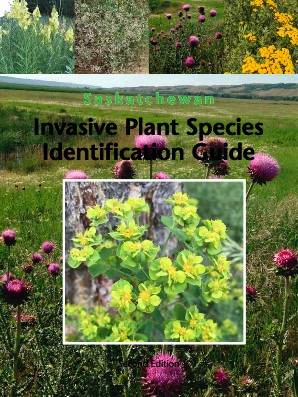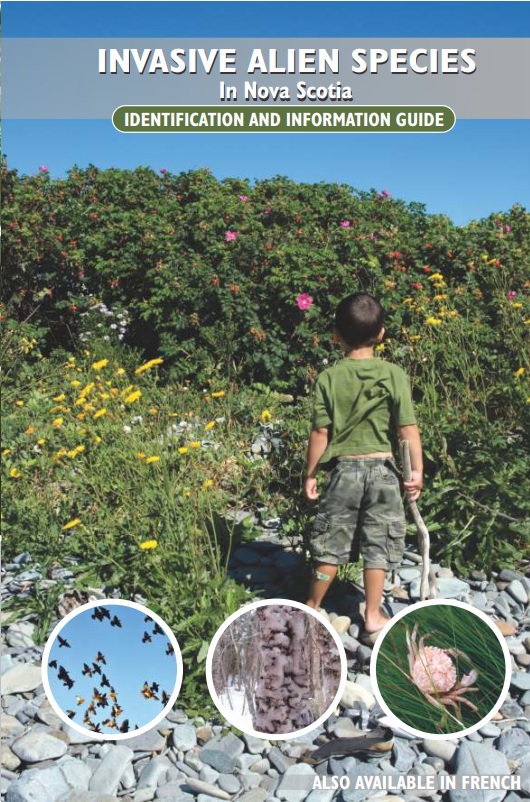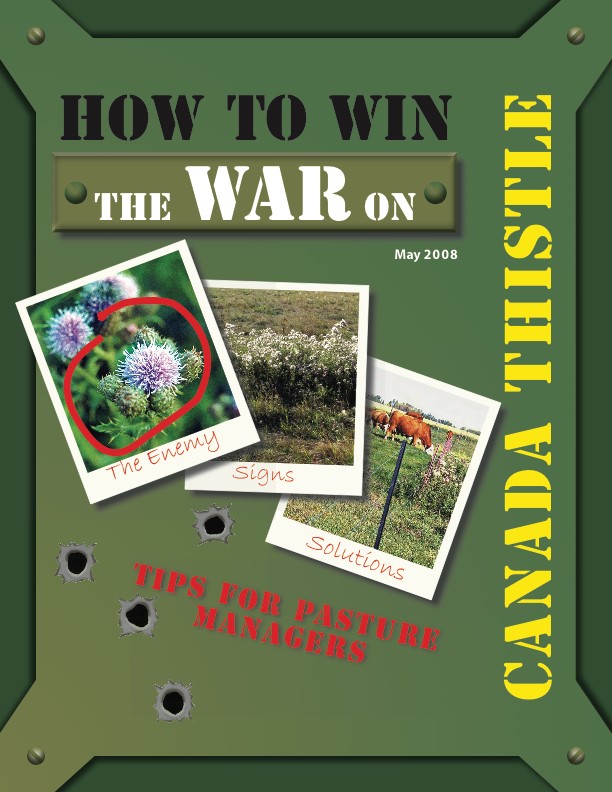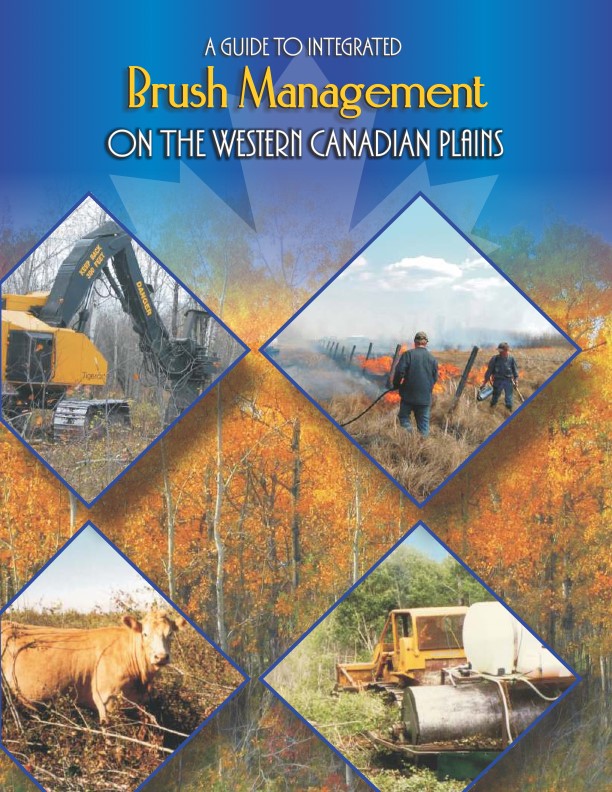
Remarque : cette page web n’est actuellement disponible qu’en anglais.
Healthy and productive pastures are the foundation of a successful and sustainable beef cattle operation. When weeds and brush encroach into hay fields, rangelands and pastures, desirable forage species are replaced, reducing productivity and profitability. Encroachment lowers overall yield and quality of a forage stand, increases costs of managing and producing livestock, and can reduce the value of rangeland.
Bushes, forbs and shrubs provide habitat for wildlife, and can make up over 20% of livestock’s diet on rangelands, as cattle graze the desirable forbs and forage plants1. Undesirable or invasive brush can impact wildlife habitat when encroachment alters native ecosystems. Proper identification is important to ensure that desirable plants are not targeted for weed and brush control.
| Key Points |
|---|
| A weed is an undesirable plant that grows profusely where it is not wanted |
| Weeds reduce the quantity and stand life of desirable forage plants in pastures and hayfields |
| Annual weeds are species that complete their life cycle within one growing season: germinating, flowering, setting seed and then dying |
| Biennial weeds complete their life cycle over two years, germinating and growing to a rosette stage in the first year; and flowering and setting seed in the second year |
| Perennial weeds live for two or more years and can reproduce sexually by seeds or vegetatively by root structures |
| Certain plants contain substances that can be poisonous to livestock |
| While both farmed cropland and pastures are susceptible to weed pressures, weed control in a healthy forage crop is primarily achieved through competition from the existing forage stand |
| Grazing management plays a key role in weed control; a healthy and well-maintained pasture is more resilient and less likely to succumb to weed pressure or infestation |
| Proper identification of the weed will determine the best control strategy |
| Weed control can be accomplished by cultural, mechanical, chemical and biological methods |
| A good weed management plan starts with cultural methods, such as grazing management, and integrates two or more additional control measures into a complete management system |
| Implementing Beneficial Management Practices (BMP’s) as part of a grazing management and weed management plan can reduce the introduction of weeds, control their spread or eliminate them |
| Certain weeds have encroached and spread across large areas of pasture and rangeland. Canada thistle and leafy spurge are two examples of weeds creating significant economic losses to producers by lost forage yield and production, as well as the costs to control further spread of the weeds |
| Forage composition and management objectives will determine the best control methods |
| Brush encroachment is pronounced in regions where moisture is abundant and soil types are favourable for woody species to grow |
| In many areas of Canada, brush encroachment by trees such as trembling aspen, willow, and shrubs such as buffaloberry and snowberry, reduces forage yields and availability to cattle |
| When determining methods to control or reduce brush, consider the cost of control relative to the increased forage production gained |
| As with weeds, a brush management program that includes repeated treatments and is included within a forage production and grazing plan will yield better results for livestock and wildlife than a piecemeal approach |
Weeds
A weed is an undesirable plant that grows profusely where it is not wanted and their negative characteristics outweigh any positive characteristics. They interfere with the utilization of land and water resources. Weeds can be plants from one area that have escaped cultivation and become invasive species once transplanted to new climates.
Weeds propagate, or reproduce by three modes: sexual, asexual and vegetative. Seeds and other reproductive structures spread by wind, water, crops, animals and human activity. Weeds generally have physiological advantages such as aggressive seed dispersal by barbs or tufts, drought resistance, or rapid early growth. Some plants are able to produce thousands of seeds that can remain dormant, yet viable in the soil for years. Others release substances that inhibit the growth of other plants2. They may have root systems that can develop buds and shoots despite cultivation.
As weeds spread, they compete for light, moisture, nutrients and space, and may slowly replace desirable hay or pasture forage species, impacting yield and profitability.
Weeds reduce the quantity and stand life of desirable forage plants in pastures and hayfields. Pastures can be impacted by annual, biennial and perennial weeds, and each region across Canada will have different weeds that are problematic. While some weeds reduce pasture yield, others are poisonous and present a health risk to livestock. When aggressive weeds overtake a pasture or hay field, they can negatively impact soil health and vegetative diversity, and therefore limit the livestock and wildlife that the land can support. Sound production practices will help to control weeds and undesirable brush. Early identification of undesirable plants or shrubs within a forage stand will facilitate control or removal of the weeds before the problem becomes unmanageable. Weed management, which includes cultural, mechanical, chemical and biological methods, must be applied and evaluated over an extended period of time to be successful.
Annual Weeds
Annual weeds are species that complete their life cycle within one growing season, germinating, flowering, setting seed and then dying. They can only reproduce by seed. This sexual reproduction requires pollination and fertilization which results in seed that can produce new plants. Annuals are further categorized as summer or winter annuals, with summer annuals germinating during higher temperatures and winter annuals germinating in fall through to March. Some examples of summer annuals are kochia, lamb’s quarters, and pigweed. Winter annuals include chickweed, downy brome, narrow-leaved hawk’s beard, buttercup, and stinkweed. Annual weeds are best controlled during the seedling and early vegetative stages as they become harder to control as the plant matures. Methods of control applied before they can set seeds will be most effective.

Downy Brome, photo credit T. Mulhern Davidson
Biennial Weeds
Biennial weeds complete their life cycle over two years, germinating and growing to a rosette stage in the first year, and flowering and setting seed in the second year, after which they die. Biennial weeds reproduce sexually through seed production. They tend to establish in areas of low soil disturbance, such as pastures, hay crops, waterways and fence rows. They often have large taproots. Examples include burdock, bull thistle, wild carrot and mullein. Biennials are easier to control while still in the rosette stage (first year of growth). Allowing them to overwinter and begin active growth the following spring will make control more difficult.
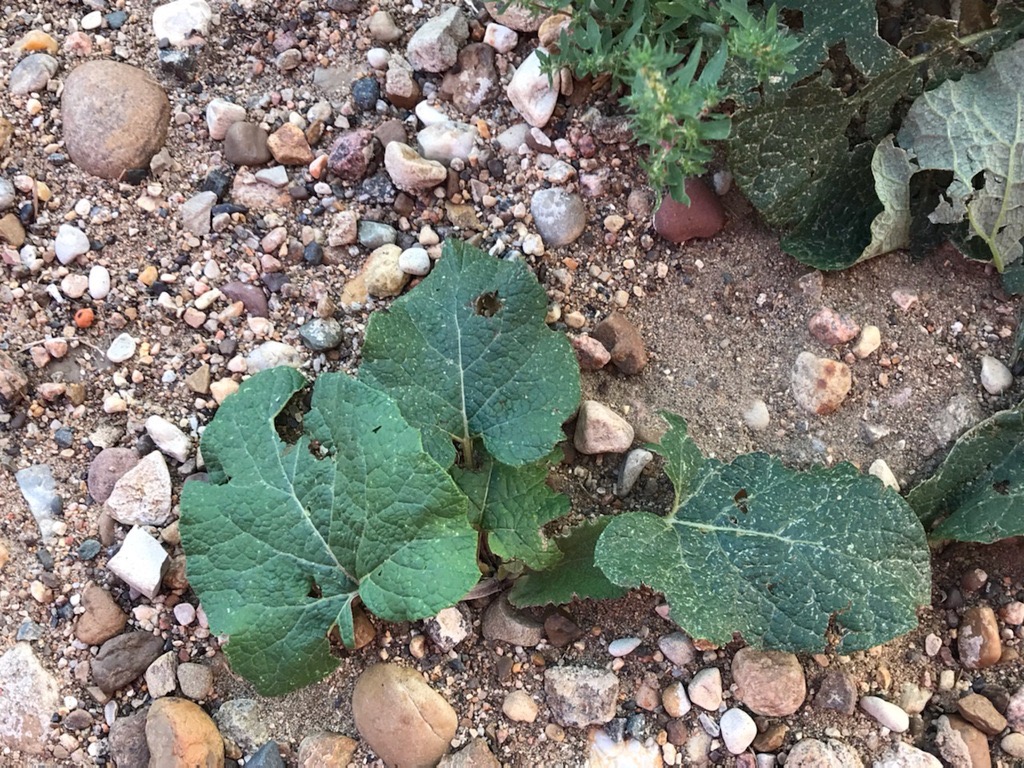
Burdock in rosette stage, photo credit T. Mulhern Davidson
Perennial Weeds

Perennial weeds live for two or more years and can reproduce sexually by seeds or vegetatively by root structures, such as rhizomes, stolons, tubers or bulbs. These vegetative structures make control more difficult; removing the above ground portion of the plant will not stop growth. Certain perennial weeds, such as Canada thistle can reproduce from very small pieces of roots. This can make mechanical control, such as cultivation, more difficult because each viable piece of root can regrow into a new plant.
Perennial weeds are best controlled during the early bud stage, about two weeks before flowering. Frequent mowing or grazing reduces perennial carbohydrate reserves and can be part of a management strategy to reduce these weeds. Late summer and early fall application of systemic herbicides can be very effective on perennials as they store carbohydrates to overwinter. Apply when the weeds are still growing, and daytime temperatures are over 10 degrees Celsius for the herbicide to be absorbed and enter the root system. Perennial weeds include Canada thistle, leafy spurge, foxtail barley, quackgrass and smooth bedstraw.
Toxic Pasture Plants
Certain plants contain substances that can be poisonous to livestock. Providing cattle access to healthy, vigorous pastures reduces risk of poisoning, as cattle will usually avoid poisonous plants if adequate forage is available. Certain toxic plants begin growth early in spring and may be grazed if cattle are turned out too early before the rest of the pasture is actively growing.
Examples of toxic plants found in Canada include:
- Death camas, which is a bulb, similar in appearance to a small onion. Cattle have consumed the bulb and been poisoned when turned out into pasture early in the growing season before the grass was actively growing.
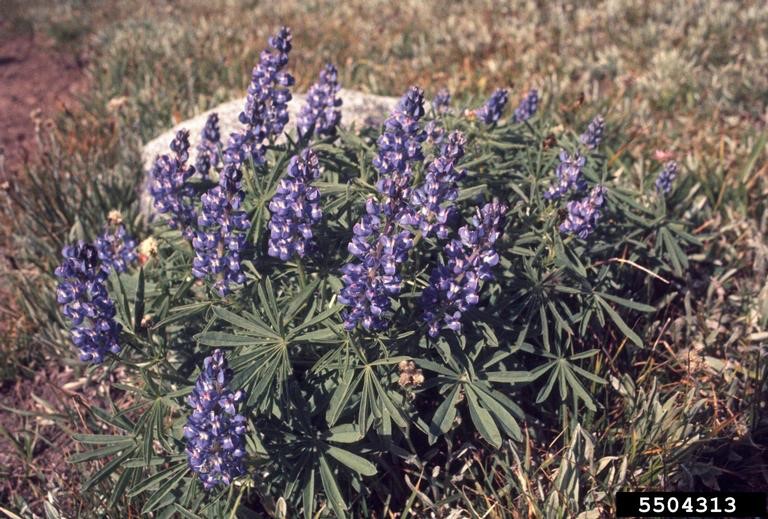
- Lupines can cause issues in pregnant cattle. Consumption in early pregnancy causes deformities in the calf, such as crooked legs, fused joints and cleft palate3.
- Red maple or oak leaves in Eastern Canada.
- Larkspur and monkshood, which grow in lush and mountainous areas and can be deadly because their toxins affect the heart.
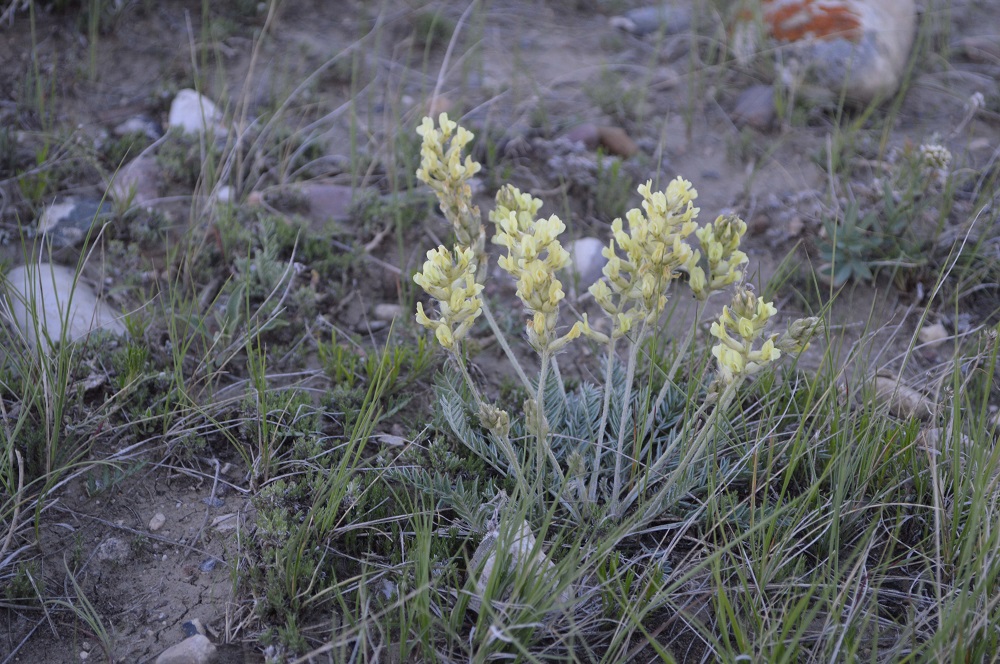
- Locoweed, found in mountains, foothills and semi-arid regions, is a legume with some types being unpalatable, with cattle only eating them when feed or forage is in short supply. Other varieties are quite palatable to cattle. Cattle who are poisoned by locoweed may become emaciated, have reproductive problems or abort their fetus, and sustain neurological damage. All parts of the plant are toxic.
- Henbane, tansy, hound’s-tongue and tall buttercup are poisonous plants that are not usually grazed by cattle unless little other forage is available.
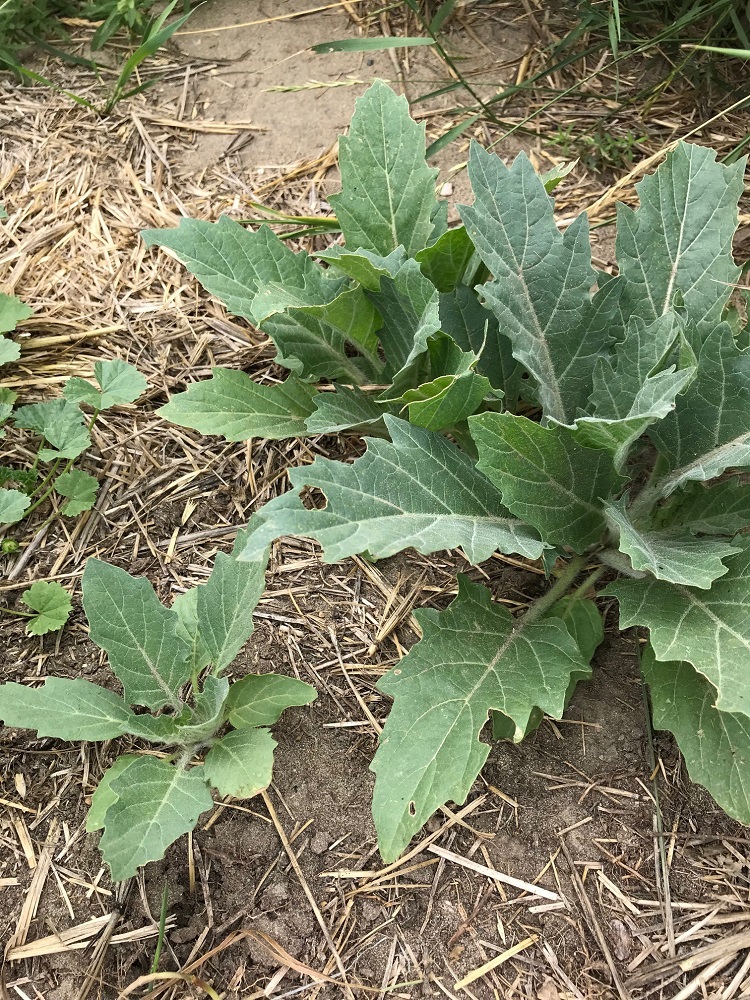
- Water hemlock, the most violently toxic plant that grows in North America4 is a perennial wetland plant that grows in moist areas of meadows, pastures and streams. Poisonous to cattle and humans, only a small amount of the toxic substance, cicutoxin, is needed to cause death within 15 minutes.
- Poison hemlock grows in wet areas near dugouts, streams or sloughs and can cause cleft palate or skeletal deformities in calves, and death within two to three hours of consumption.
Scouting fields and pastures as part of an integrated management plan will allow producers to identify and control poisonous plants that can directly impact livestock health, safety and productivity. Ensuring that cattle are not turned out to pasture until forages are actively growing reduces the probability of cattle eating poisonous plants. Management that improves and maintains healthy pastures and hay fields can reduce incidence of poisonous plants and possible animal consumption.
The following guide provides more information on poisonous plants of Western Canada.
Regulating Noxious and Invasive Weeds
Federally, the Plant Protection Act is in place to “prevent the importation, exportation and spread of pests injurious to plants and to provide for their control and eradication and for the certification of plants and other things”5. The purpose of the Act is to “protect plant life and the agricultural and forestry sectors of the Canadian economy by preventing the importation, exportation and spread of pests and by controlling or eradicating pests in Canada”. The Canadian Food Inspection Agency designates the Prohibited Noxious Weeds in the Weeds Seeds Order under the Seeds Act.
Provinces and some municipalities identify weeds of concern specific to their jurisdiction and rely on weed control acts to assist with management. Provincial weed control acts also define any action required with the discovery of Prohibited Noxious, Noxious or Nuisance weeds on a property. Many provinces have weed specialists within their Ministry of Agriculture, or through rural municipalities or municipal districts. These specialists can assist with proper identification and provide advice regarding effective control methods. Early detection and action will generate the best results. When outbreaks of weeds occur, weed inspectors have authority to write orders to enforce containment or eradication of the weeds.
Landowners and tenantsare responsible for controlling noxious weeds and destroying prohibited noxious weeds.
Prohibited Noxious Weeds – non-native weeds with a restricted distribution in an area that risks spreading and causing significant economic or ecological impact. These plants pose an extreme risk to natural and agricultural areas. Inspection programs are in place to identify and track these weeds. Weeds in this category are either not found in certain provinces or are in a few locations such that eradication is possible. Rapid response is required. Once identified, these weeds must be destroyed by land owners.
Noxious Weeds – non-native species that are widely distributed that can spread easily from existing infestations to other areas, causing significant economic or ecological impact. Weeds in this category are considered too widely distributed to eradicate. These weeds must be controlled or contained.
Nuisance Weeds – non-native species that have aggressive behaviour over native or preferred plant species. These weeds should be monitored, but do not require immediate action to eradicate or control. However, early control provides best results.
Many provincial or municipal weed identification guides are available to assist producers. Contact local offices or websites to learn which nuisance, noxious and prohibited noxious weeds are problematic in each area. Examples of several guides are included below (click on each image to open the file).
Many weed related resources and descriptions of common weeds in Western Canada are listed in the Forage U-Pick Tool.
Weed Control
While both farmed cropland and pastures are susceptible to weed pressures, weed control in a forage crop is primarily achieved through maintaining a healthy forage stand. Weed management on cropland often has more flexibility in control methods such as tillage, chemical control and crop rotation. Tame and native pastures require more careful management to reduce undesirable plants without impacting the desirable forage plants. Selective broadleaf herbicides will kill weeds but will also kill or damage forage plants including legumes such as alfalfa, sainfoin and bird’s-foot trefoil. Native prairie is home to many diverse plants and animals and chemical application can be very damaging. Widespread application of herbicides is not recommended on tame or native pastures.
The best defense against weeds is a well-managed, healthy, vigorous forage stand that competes effectively with weeds and reduces opportunities for weed establishment.
Grazing management plays a key role in weed control; a healthy and well-maintained pasture is more resilient, and less likely to succumb to weed pressure or infestation. Overgrazed pastures from continuous grazing or overstocking weakens forage stands, making them susceptible to weed encroachment. Stocking pastures appropriately, as a part of a sustainable grazing plan will help rangelands and pastures remain healthy and vigorous. For more information on calculating stocking rates, see the Carrying Capacity Calculator.
Weeds can be introduced through many pathways and vectors. They include:
- purchasing feed such as baled hay, greenfeed, or straw that contains weed seeds
- seed distribution by wind (e.g., kochia or baby’s breath)
- flooding that carries seeds onto a pasture (e.g. red bartsia)
- in contaminated soil or gravel
- custom workers, including manure haulers, truckers or fencing crews
- construction or energy workers who may introduce weed seeds or plant parts on their equipment
- by cattle and wildlife
- animals sent to rental pastures that are heavily infested with weeds may bring back weed seeds in their manure upon their return, to germinate in home pastures. Purchasing new animals can also introduce weed seeds in manure.
Avoid unintentionally importing weeds from elsewhere when purchasing hay or greenfeed. If renting or purchasing pasture, conduct an assessment or enlist the services of a weed specialist or agrologist to determine if any troublesome or noxious weeds are present prior to finalizing contracts. Prior to hiring custom operators, such as excavators or fencers, communicate concerns regarding weed containment. Prior to allowing road construction, seismic or energy development, ensure operators have an appropriate weed prevention and control strategy in place. It can be very expensive to clean up someone else’s weed problems, especially in pastures, where control options may be limited and herbicides can be costly. With some weeds developing resistance to herbicides it can be increasingly difficult to control a new weed problem once it is introduced. Scouting rangelands and hay fields twice per year will help identify any newly introduced weeds, as well as changes in existing weed populations. Proper weed identification will determine the best control strategy.
Weed control can be accomplished by cultural, mechanical, chemical and biological methods.
A good weed management plan starts with cultural methods and integrates two or more additional control measures into a complete management system. The system must be applied and evaluated over an extended period of time to be successful.
Cultural controls include proper grazing management, irrigation, fertilization, and seeding vigorously growing, competitive, desirable plant species to suppress weed growth and production while promoting the development of the desired plants. Maintaining healthy forage stands with a grazing management plan will help keep weeds from being introduced or getting established.
Mechanical controls include tillage, mowing, mulching, and burning to remove, injure, kill, or make growing conditions unfavourable for weeds. Annual weeds can be controlled by mowing prior to seed set. They can also be tilled or hand dug. Mowing perennials can reduce seed set, but several mowings are usually required to reduce the energy reserves of the plant’s root system and decrease its vigour. Certain weeds, such as Canada thistle, reproduce from small pieces of roots. Root fragments can survive for one hundred days under adverse conditions, making cultivation less effective than herbicide for control6. In these instances, mechanical control may actually increase the number of weeds, as the newly cultivated root pieces establish new plants.
Chemical controls (herbicides) can be challenging in pastures due to diverse plant stands. Non-selective herbicides will kill all vegetation and selective herbicides may eliminate certain weeds, while also impacting desirable forages with similar characteristics (e.g. broadleaf vs. grass). Annual weeds in the seedling stage are most susceptible to control with herbicides. Spray biennial weeds in the rosette stage prior to bolting. Perennials are most susceptible to control with systemic herbicides in the bud to bloom stage or in early fall. Most herbicides for broadleaf control in grass pasture systems should not be applied to seedling forage grass until visible tillers are present. Established forage grasses and legumes are more herbicide tolerant than seedling forages. Most herbicides have haying or grazing restrictions following application. Contact local weed management organizations or extension offices to learn whether cost-sharing weed management programs are available. Most provinces compile a guide to crop protection annually that is available online or by contacting ministry of agriculture offices.
Consult an agrologist or weed specialist to determine the most effective herbicide to target specific weeds. Apply at the right rate and the right time to achieve best results. Application of herbicides to certain weeds at inadequate rates, or by methods not approved by the manufacturer has contributed to weeds developing resistance to certain products. These resistant weeds become increasingly difficult to control. Following best management practices and application rates will reduce the chance of creating resistance issues.
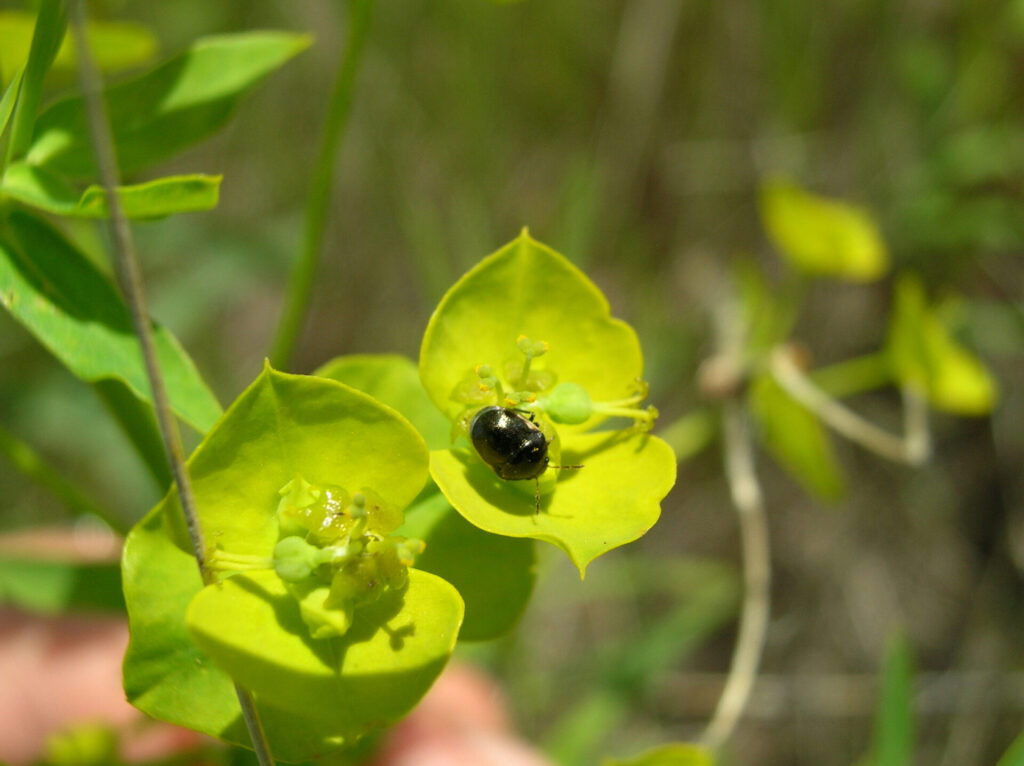
Classical biological control uses natural enemies of weeds, such as insects or disease organisms. Biological control may also include the use of sheep, cattle, goats, or other large herbivores to manage weeds. While biological control is not intended to eradicate target weeds, it can be an environmentally safe, cost effective way to reduce weed pressures.
There has been interest in using beneficial insects to control thistles and some other perennial weeds. A study by Stephen Crozier assessed the effectiveness of biological control insects that had previously been introduced in Canada, focusing on field studies in Nova Scotia. Following up on insect biocontrol introductions carried out in the 1980s and 1990s, the study surveyed 18 different insects on ten target weed species. The five insects showing the greatest potential to control weeds were: Hadroplontus litura (a European weevil) for Canada thistle control; Urophora stylata (a gall fly) for bull thistle control; Longitarsus jacobaeae (a flea beetle) for tansy ragwort control; Deloya guttata (a leaf beetle) for bindweed control and Galerucella calmariensis (a European beetle) for purple loosestrife control7.
Targeted browsing of weeds by goats or sheep has been used with some success in larger areas of infestation where herbicide control is not practical. While cattle tend to avoid leafy spurge and thistle, targeted grazing as part of an integrated management plan can reduce weed density. Goats and sheep will also graze undesirable plants such as thistle, absinthe, buckbrush and aspen suckers. Leafy spurge can comprise up to 40-50% of a sheep’s diet, and goats can consume even more, at 60-80% of their diet8. Fencing, herding, and predator control are required to keep goats and sheep grazing targeted areas, and safe from predators such as coyotes.
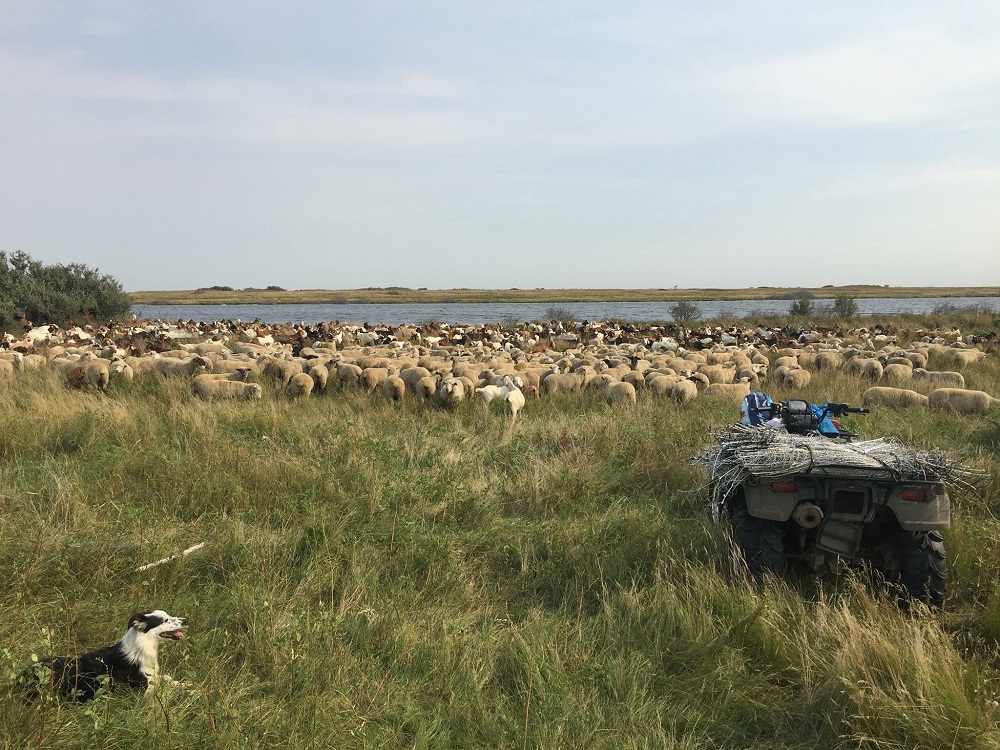
Sheep and goats grazing, photo credit S. Chutter
Invasive plant species threaten the productivity, profitability, environmental resilience, and biodiversity of grazing operations. Prevention is the first, best, and most affordable option.
When weeds have escaped early detection and control treatments, aggressive approaches that include a combination of cultural, mechanical, chemical, and biological control may be required. Regaining control and reducing weed infestations may take years. Native grasslands can be problematic for weed control because of the diverse mixtures of legumes, shrubs and grasses. Difficult to re-establish, these pastures require extra care to contain weeds. Tame hay fields and pastures may have more flexibility with herbicide options. Rejuvenating pastures and tame forage stands may increase plant growth and provide healthy competition with weeds. In the worst case scenario, it may be more practical and economical to terminate a forage stand and re-seed to establish a new stand.
Beneficial Management Practices
Implementing Beneficial Management Practices (BMPs) as part of a grazing management and weed management plan can reduce the introduction of weeds, control their spread or eliminate them.
Economic Costs of Weed Infestation – Early Control is Key
Certain weeds have encroached and spread across large areas of pasture and rangeland. Canada thistle and leafy spurge are two examples of weeds creating significant economic losses to producers by lost forage yield and production, as well as the costs to control further spread of the weeds. A recent survey conducted in Montana9 reported that Canada thistle was present on 64% of respondents’ pastures, while leafy spurge was present on 45%, with these two species causing the greatest reductions in livestock forage. The survey responses were combined with forage-loss models from field data to estimate the cost of noxious weed management and forage losses to be $3.50 USD/hectare ($1.40 USD/acre).
Research conducted within the Aspen Parkland region of Alberta10 examined control methods for Canada thistle on pasture and helped to develop integrated management recommendations. This was a combined effort between Alberta Agricultural Research Institute, the University of Alberta, Alberta Agriculture, Food and Rural Development, BASF Canada and Dow AgroSciences and a dozen municipal counties. While some variability occurred, likely due to soils and local growing conditions, the forage yields generally declined with increased Canada thistle density. Losses approached 2kg/ha of forage for each 1kg/ha of the weed11. The study examined whether a one-time herbicide application or mowing could provide effective control on pastures, and whether fertilizer would help with weed control over the next three years. They found that fertilization without control methods increased Canada thistle abundance by approximately twenty five percent, and a one-time mowing treatment also increased abundance. A combination of fertilization and mowing was also ineffective. Herbicides, including Grazon™ and Lontrel™, applied at early bud stage in July, combined with fertilization of the pasture, had the greatest suppression at the end of the third growing season. It should be noted however, that the herbicides reduced forbs in the stands, and in native stands, it also reduced species richness, diversity and native species cover. Forage composition and management objectives will determine the best control methods.
Researchers also compared grazing systems to evaluate any impact upon Canada thistle abundance. In comparing continuous, high intensity/low frequency (HILF) and short duration grazing, they found that continuous grazing resulted in the lowest forage yield and the greatest prevalence of Canada thistle, while the high intensity/low frequency grazing system helped to create a highly competitive stand of perennial grasses which minimized thistle shoot development. Researcher Edward Bork explained that with the HILF treatment, most of the Canada thistle remained in the rosette stage, and that each grazing period with HILF caused an incremental decline in thistle abundance over time. In this study, Canada thistle was never eliminated, but the use of integrated approaches which combined herbicides, fertilization and rotational grazing can combine to minimize the impact of the weed on forage production in the Aspen Parkland region.
Weed infestations can result in significant economic costs. For example, an economic assessment of leafy spurge in southern Manitoba in 2010 calculated the total economic impact on 1.2 million acres in that province to be $40.2 million, with $10.2 million directly as a result of the lost grazing capacity of pastures for livestock12. This amount was double the loss estimated by a previous assessment, Leafy Spurge Impact Assessment, 199913which indicated that 340,000 acres in southern Manitoba were affected, with a total economic loss of $20 million based on direct costs.
Control of weeds that have spread throughout pastures is time consuming and costly. As stocking rates decline and land values potentially drop due to infestation and lost productivity, the economic impact increases. While a small weed problem can be easy to ignore, the costs to control it will only increase as it spreads, requiring more resources to control. Early identification and control reduce the number of acres affected and minimize forage production losses, decreasing the negative economic impact.
Brush

Trees, shrubs and bushes, collectively referred to as “brush” provide habitat for birds and wildlife, catch snow and preserve moisture, and can provide emergency food and shelter for livestock. Some brush cover is recommended for many grazing lands, including in the Aspen Parkland region of the western Canadian plains.In many areas of Canada, brush encroachment by trees such as trembling aspen, willow, and shrubs such as buffaloberry, hazelnut, and snowberry, reduces forage yields and availability to cattle. The carrying capacity of this land is highly variable and can depend upon soil fertility, moisture-holding capacity, canopy density and the amount of sunlight reaching the ground.
Many of these trees, shrubs and bushes have adapted to survive volatile weather patterns and can provide a food source for cattle when grasses and forages are reduced during periods of drought or flooding. While alder, birch, beech, snowberry, hazelnut, oak and balsam poplar are not palatable to cattle, many of the other trees and shrubs in the prairie and boreal forests can be grazed by livestock. During the early part of the growing season, cattle will graze aspen poplar, wild rose, wild raspberry, wild gooseberry, saskatoon, willow, ash, chokecherry, and pin cherry in small amounts. In spring and early summer, young aspen suckers are grazed by livestock because the stems are tender. In late summer, cattle strip and eat the leaves instead.
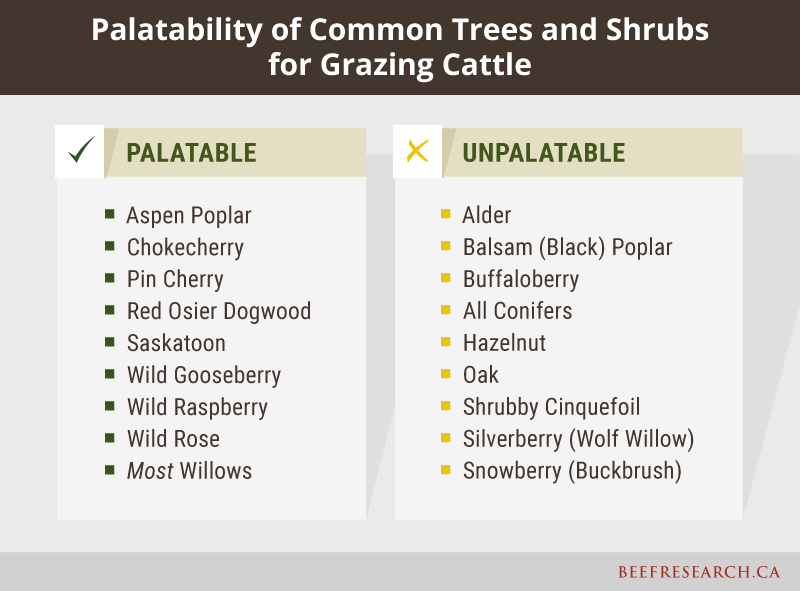
Brush encroachment is pronounced in regions where moisture is abundant and soil types are favourable for woody species to grow. For thousands of years, fires occurred on the Canadian prairies, naturally controlling trees and shrubs. These hardy plant species have adapted to re-sprout following disturbances including fire, insects such as tent caterpillars, windstorms, mowing or browsing. If the top growth is destroyed, there are dormant buds in the trunks and roots that will develop into new shoots.
Forage production increases when the brush canopy is removed. While cattle will use trees and shrubs for shade, as well as graze some of the leaves and berries, they are attracted to cleared areas to graze and rest. Carrying capacity of bush is estimated at 25% of open grassland14 and new grass/legume forage as well as woody forages in newly cleared areas appear to be more palatable than those growing under a canopy.
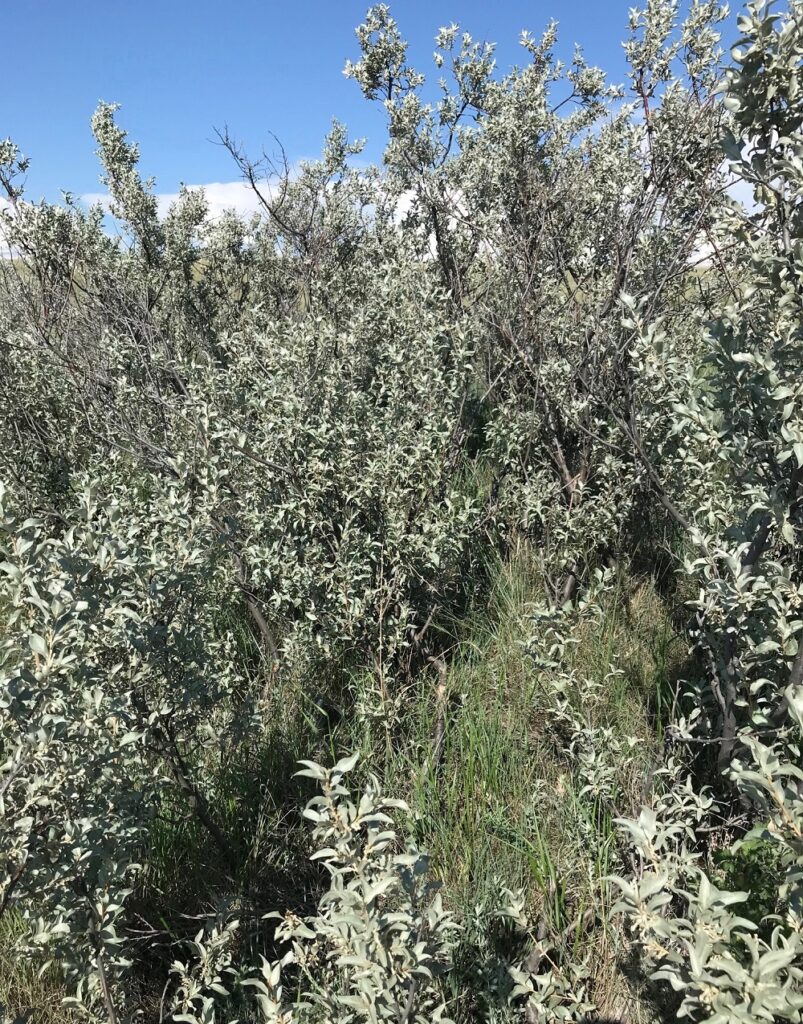
Properly identify forages and shrubs to ensure that desirable species are not accidentally targeted if controlling woody species. For example, silverberry (wolf willow) is a shrub that fixes nitrogen in the soil and allows enough light through the canopy to permit grass growth. The woody stems act as a partial barrier to grazing, enabling greater grass productivity and plant diversity under the shrubs than in open grassland. While palatability is rated as poor for cattle, some producers report that their herds will browse the tender leaves in spring. It is often a valuable source of shelter for livestock grazing winter pastures. Silverberry is an important food source for wildlife such as moose, deer, pronghorn, waterfowl and upland birds who often graze or browse the leaves and berries. It also provides protection and nesting cover for many species, including snowshoe hare.
Brush Control
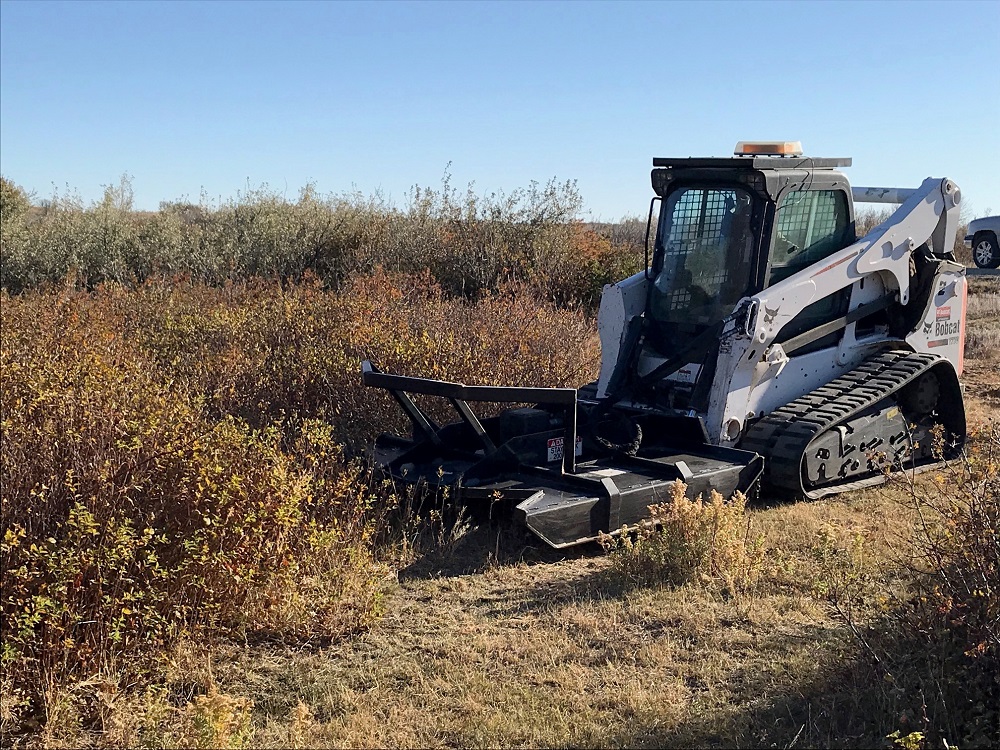
When determining methods to control or reduce brush, consider the cost of control relative to the increased forage production gained. Production improvements will vary greatly from one operation to another; create a budget to estimate costs of brush removal versus the anticipated gains of increased forage yield and grazing days.
Monitor brush annually to determine if control methods are effective and to track and estimate costs and improvements. Consider such questions:
- Am I losing forage productivity?
- Is the brush treatment working?
- How quickly is brush re-establishing and taking over?
- Is my grazing management plan reducing or increasing brush encroachment?
- Which treatment, or combination of treatments, is providing the best results at the most competitive cost?
Cultural, mechanical and chemical methods have all been utilized in different areas with some success. As with weeds, a brush management program that includes repeated treatments and is included within a forage production and grazing plan will yield better results for livestock and wildlife than a piecemeal approach.
Cultural controls include grazing management strategies to suppress undesirable brush growth while promoting the development of the desired plants and forages.

Livestock grazing of woody species is an inexpensive and effective brush management tool when managed properly. Carefully planned and executed rotational grazing systems can stave off brush encroachment while optimizing forage yields and preserving natural wooded areas.
Mechanical controls to combat brush encroachment include the use of mowers, bulldozers, roller choppers, bark scrapers, drags, girdling trees and cultivation. Success of mechanical controls generally depends on repeated efforts. Trees and shrubs have adapted to survive many adverse conditions. One year of cultivation for example, may provide short term benefits, but create more shoots in the following year. Impeding top growth will trigger bud formation and sucker regeneration along roots with stem and sucker density increasing five to ten times following mechanical disturbance14. Manual cutting of hardwoods such as cottonwood, big leaf maple, aspen and birch is not usually effective as the number of shoots per stump greatly increases the following year. Cutting shrubs such as willow, rose, alder, thimbleberry and snowberry provides short term control. Without additional and subsequent treatments, they can return to pre-treatment height and cover level within two years15. Prior to implementing mechanical methods, create a plan to continue treatment in the following years. Match cattle herd size with the area being treated; about two to five cattle per acre can help graze palatable woody regrowth the following year. Treating an area that is too large will mean that the cattle can’t effectively control the brush and alternative treatments such as chemical or additional mechanical methods will be required.
The size and species of the trees and shrubs, as well as the terrain will impact the type of mechanical treatment. Large trees may require cutting and removal or clearing and piling with equipment such as a bulldozer. Smaller trees and shrubs may be cleared by scrapers, drum rollers, dozers or drags. Match the treatment time with the equipment selected; for example, winter is better suited for large dozers as the frozen trees are more brittle, snapping off more easily, and the frozen ground prevents equipment from sinking into soft soils. Scrapers, a mechanical device that drags across a bushed area usually achieve best results in June to July, when the small saplings are actively growing and the tender bark scrapes off well. Time, labour and costs will also factor into the optimal mechanical methods used to control trees and brush.
Some comparisons of costs and methods can be found in the Guide to Integrated Brush Management on the Western Canadian Plains.
Chemical controls work best when applied to plants that are actively growing and that are at an early stage of growth. Consult with an agronomist to determine the best herbicide to use based on the plant composition and stage of growth. Follow all labels and directions for use carefully. Be aware that herbicides may have restrictions on time of re-entry for grazing and follow the guidelines on the label. Herbicide use is most effective as a brush control method when combined with other techniques and treatments, such as cultural and mechanical.
Prescribed burning is an inexpensive and effective method of managing brush when combined with appropriate grazing practices. Once a common means of control, the risk of fire escape, as well as government policies and concern about environmental and climate impacts have reduced the use of this control method. Consult with local officials to ensure compliance with regulations and procedures prior to using prescribed burns as a technique for brush control.
A long-term, integrated approach to brush management will include cultural, mechanical and chemical treatments for best results. Creating a brush management strategy can assist with estimating costs and anticipated benefits. Local conditions and specific management objectives will vary greatly impacting the combination and timing of treatment methods. Consult with local authorities, such as the ministry of forestry or environment to ensure that proper procedures and regulations are adhered to. Producers operating on Crown land may have additional requirements or require approvals prior to commencing land clearing.
Conclusion
Weeds and brush that invade forage stands impact production, yield and profitability. Hayfields and pastures can be impacted by annual, biennial and perennial weeds. While some weeds are present across Canada, each region will have specific plants that are problematic. An effective control strategy will include several methods that may be cultural, mechanical, chemical or biological in nature.
The economic cost of weed infestation and control can be significant. Weed control falls under both federal and provincial jurisdiction and control or eradication is dictated by the classification of the weed. Some plants reduce pasture yield while others are poisonous and present a health risk to livestock. When aggressive weeds become an infestation, they can negatively impact soil health and vegetative diversity, limiting the livestock and wildlife that the land can support. Monitoring pastures and hay fields frequently will assist in identifying potential issues early to allow successful control. Keeping pastures stocked appropriately as part of a grazing management plan can help forage stands remain healthy and out compete weeds.
Brush, a valuable resource for wildlife, birds and small mammals can be part of a grazing management plan. Wildlife and livestock graze the tender shoots and leaves and use the brush for shelter in summer heat and for protection from winter winds. But left unchecked, brush can encroach into grasslands, reducing forage production and carrying capacity over time. Regularly removing brush canopy can maintain or increase forage production and stocking capacity.
Take a long-term approach to both weed and brush control, monitoring often and intervening early to control undesirable plants, shrubs or bushes.
- References
-
- Shoup, D. Brush and Weed Control in Pasture and Rangeland. Kansas State University.
- National Forage & Grasslands Curriculum, 2020. Oregon State University.
- Thomas, H.S. Beware of toxic plants in pastures. 2018. Canadian Cattlemen: The Beef Maga-zine.
- USDA Agricultural Research Service. Water Hemlock.
- Government of Canada. 1990. Plant Protection Act.
- Alberta Ministry of Agriculture and Forestry. Noxious weeds and plants.
- Crozier, S. 2006. Rearing, Release and Distribution of Insects for Biological Control of Pasture Weeds, BCRC Project 3.24.
- Manitoba Agriculture. Multi-species Grazing for Leafy Spurge.
- Mangold, J.M., K.B. Fuller, S.C. Davis and M.J. Rinella. 2018. The Economic Cost of Noxious Weeds on Montana Grazing Lands. Cambridge University Press.
- Grekul, C.W. and E.W. Bork. 2004. Herbage Yield Losses in Perennial Pasture Due to Cana-da Thistle (Cirsium arvense). Weed Technology: July 2004, Vol. 18, No. 3, pp. 784-794.
- Barker, B. 2007. Integrated Canada thistle control on pasture. Top Crop Manager.
- Rempel, K. 2010. Economic Impact Assessment of Leafy Spurge in Southern Manitoba. Bran-don University.
- Leafy Spurge Stakeholders Group. 1999. Leafy spurge impact assessment. Brandon, MB: WESTARC Group.
- Moss, R., B. Gardiner, A. Bailey and G. Oliver. Editors. 2008. A Guide to Integrated Brush Man-agement on the Western Canadian Plains. Manitoba Forage Council, Brandon, MB.
- Hart, D. and P. G. Comeau. BC Ministry of Forests. 1992. Manual Brushing for Forest Vegeta-tion Management in British Columbia: A Review of Current Knowledge and Information Needs.
Feedback
Feedback and questions on the content of this page are welcome. Please email us.
Expert Review
This content was last reviewed September 2020.
Ce contenu a été révisé pour la dernière fois en Janvier 2024.
